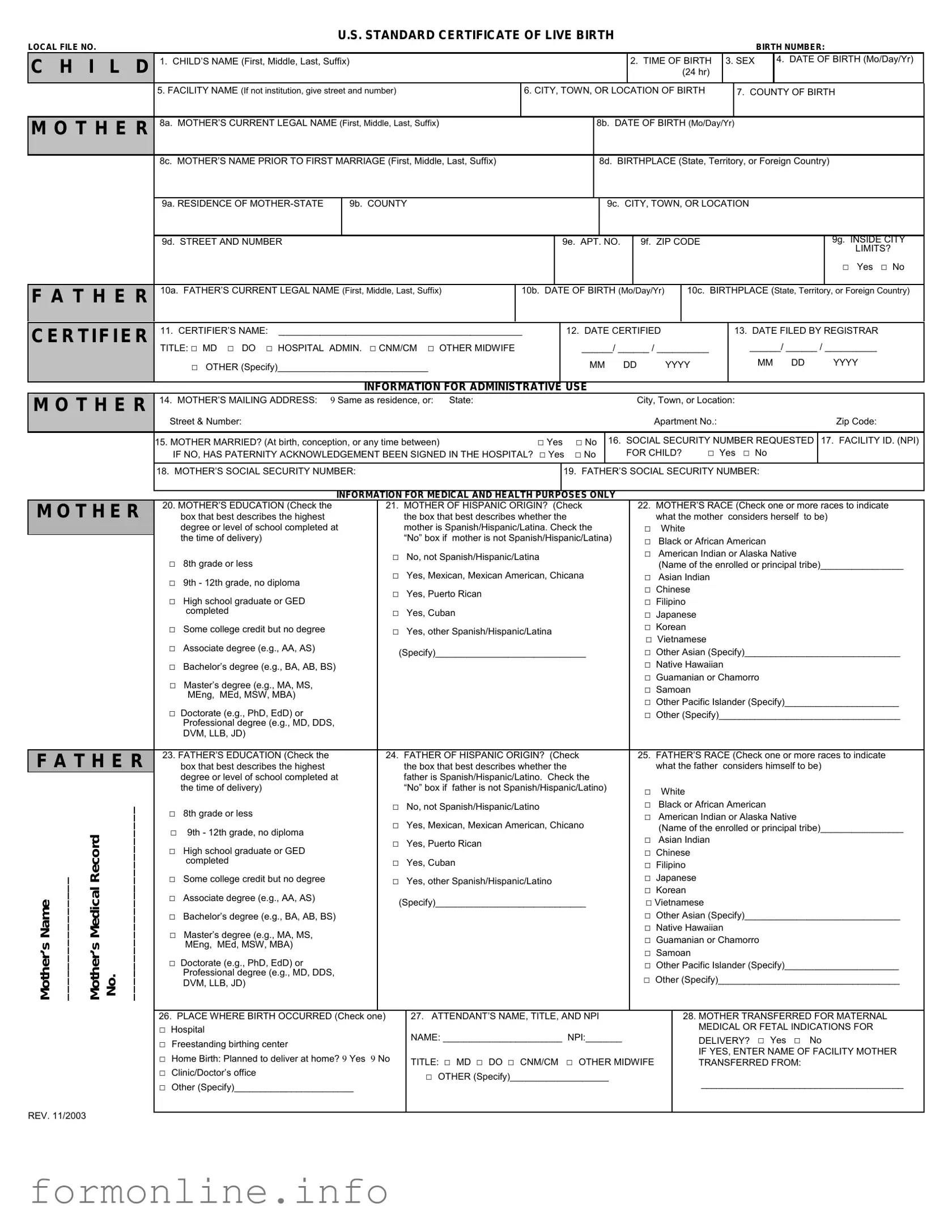|
MOTHER |
29a. DATE OF FIRST PRENATAL CARE VISIT |
|
29b. DATE OF LAST PRENATAL CARE VISIT |
30. TOTAL NUMBER OF PRENATAL VISITS FOR THIS PREGNANCY |
|
______ /________/ __________ □ No Prenatal Care |
|
|
______ /________/ __________ |
|
|
|
|
|
|
|
|
|
|
M M |
D D |
|
|
|
YYYY |
|
|
|
M M |
D D |
YYYY |
|
|
_________________________ (If none, enter A0".) |
|
|
|
|
|
|
|
|
|
|
|
|
|
|
31. MOTHER’S HEIGHT |
32. MOTHER’S |
PREPREGNANCY WEIGHT |
33. MOTHER’S WEIGHT |
AT DELIVERY |
34. DID MOTHER GET WIC FOOD FOR HERSELF |
|
|
_______ (feet/inches) |
_________ (pounds) |
|
|
_________ (pounds) |
|
|
DURING THIS PREGNANCY? □ Yes □ No |
|
|
35. NUMBER OF PREVIOUS |
36. NUMBER OF OTHER |
37. CIGARETTE SMOKING BEFORE AND DURING PREGNANCY |
|
38. PRINCIPAL SOURCE OF |
|
|
LIVE BIRTHS (Do not include |
PREGNANCY OUTCOMES |
For each time period, enter either the number of cigarettes or the |
|
PAYMENT FOR THIS |
|
|
this child) |
|
|
|
|
(spontaneous or induced |
number of packs of cigarettes smoked. IF NONE, ENTER A0". |
|
DELIVERY |
|
|
|
|
|
|
|
|
|
losses or ectopic pregnancies) |
Average number of cigarettes or packs of cigarettes smoked per day. |
□ Private Insurance |
|
|
35a. |
Now Living |
|
35b. Now Dead |
36a. Other Outcomes |
|
|
|
Number _____ |
|
|
Number _____ |
Number _____ |
|
|
|
|
|
|
|
# of cigarettes |
# of packs |
□ Medicaid |
|
|
|
|
|
|
|
Three Months Before Pregnancy |
_________ |
|
OR |
________ |
□ Self-pay |
|
|
|
|
|
|
|
|
|
|
|
|
|
First Three Months of Pregnancy |
_________ |
|
OR |
________ |
□ Other |
|
|
□ None |
|
|
|
□ None |
□ None |
|
|
|
Second Three Months of Pregnancy _________ |
OR |
________ |
|
|
|
|
|
|
|
|
(Specify) _______________ |
|
|
|
|
|
|
|
|
|
|
|
|
|
Third Trimester of Pregnancy |
_________ |
OR |
________ |
|
|
|
|
|
|
|
|
|
|
|
|
|
|
|
|
|
|
|
|
|
|
|
|
|
|
35c. DATE OF LAST LIVE BIRTH |
36b. DATE OF LAST OTHER |
39. DATE LAST NORMAL MENSES BEGAN |
|
40. MOTHER’S MEDICAL RECORD NUMBER |
|
|
|
_______/________ |
PREGNANCY OUTCOME |
______ /________/ __________ |
|
|
|
|
|
|
|
|
|
|
MM |
Y Y Y Y |
_______/________ |
M M |
D D |
YYYY |
|
|
|
|
|
|
|
|
|
|
|
|
|
|
|
MM |
Y Y Y Y |
|
|
|
|
|
|
|
|
|
|
|
|
|
|
|
|
|
|
|
|
|
MEDICAL |
41. RISK FACTORS IN THIS PREGNANCY |
|
43. OBSTETRIC PROCEDURES (Check all that apply) |
46. METHOD OF DELIVERY |
|
|
|
(Check all that apply) |
|
|
|
|
|
|
|
|
|
|
|
|
|
|
|
|
AND |
Diabetes |
|
|
|
|
|
|
|
□ Cervical cerclage |
|
|
|
|
|
|
A. Was delivery with forceps attempted but |
|
HEALTH |
□ |
|
Prepregnancy |
(Diagnosis prior to this pregnancy) |
|
□ Tocolysis |
|
|
|
|
|
|
|
unsuccessful? |
|
|
□ |
|
Gestational |
|
(Diagnosis in this pregnancy) |
|
|
External cephalic version: |
|
|
|
|
|
|
□ Yes |
□ No |
|
INFORMATION |
|
|
|
|
|
|
|
|
|
|
|
|
|
|
|
B. Was delivery with vacuum extraction attempted |
|
Hypertension |
|
|
|
|
|
|
|
□ Successful |
|
|
|
|
|
|
|
|
□ |
|
Prepregnancy |
(Chronic) |
|
|
|
□ Failed |
|
|
|
|
|
|
|
but unsuccessful? |
|
|
|
|
|
|
|
|
|
|
|
|
|
|
|
□ |
|
Gestational |
(PIH, preeclampsia) |
|
|
□ None of the above |
|
|
|
|
|
|
|
□ Yes |
□ No |
|
|
□ |
|
Eclampsia |
|
|
|
|
|
|
|
|
|
|
|
C. Fetal presentation at birth |
|
|
|
|
|
|
|
|
|
|
|
|
|
|
|
|
|
|
|
|
|
|
□ Previous preterm birth |
|
|
|
|
|
|
|
|
|
|
|
□ |
Cephalic |
|
|
|
|
|
44. ONSET OF LABOR (Check all that apply) |
|
|
|
|
|
|
|
|
|
□ |
Breech |
|
|
|
|
|
|
|
|
|
|
|
|
|
|
|
|
|
|
|
|
|
|
|
|
|
|
□ Other previous poor pregnancy outcome (Includes |
|
□ Premature Rupture of the Membranes (prolonged, ∃12 hrs.) |
□ |
Other |
|
|
|
|
perinatal death, small-for-gestational age/intrauterine |
|
|
|
|
|
|
|
|
|
D. Final route and method of delivery (Check one) |
|
|
growth restricted birth) |
|
|
□ Precipitous Labor (<3 hrs.) |
|
|
|
|
|
|
|
|
|
|
|
|
□ Vaginal/Spontaneous |
|
|
|
|
|
|
|
|
|
|
|
|
|
|
|
|
|
|
|
|
|
|
□ Pregnancy resulted from infertility treatment-If yes, |
|
□ Prolonged Labor (∃ 20 hrs.) |
|
|
|
|
□ Vaginal/Forceps |
|
|
check all that apply: |
|
|
|
|
|
|
|
|
|
|
|
□ Vaginal/Vacuum |
|
|
□ Fertility-enhancing drugs, Artificial insemination or |
□ None of the above |
|
|
|
|
|
|
□ Cesarean |
|
|
|
|
|
Intrauterine insemination |
|
|
|
|
|
|
|
|
|
|
|
|
If cesarean, was a trial of labor attempted? |
|
|
□ Assisted reproductive technology (e.g., in vitro |
|
|
|
|
|
|
|
|
|
|
|
□ Yes |
|
|
|
|
|
45. CHARACTERISTICS OF LABOR AND DELIVERY |
|
|
|
|
|
|
|
|
|
fertilization (IVF), gamete intrafallopian |
|
|
|
|
□ No |
|
|
|
|
|
|
|
|
|
(Check all that |
apply) |
|
|
|
|
|
|
|
|
|
|
|
transfer |
(GIFT)) |
|
|
|
|
|
|
|
|
|
|
|
|
|
|
|
|
|
|
|
|
|
□ |
Induction of labor |
|
|
|
|
|
|
47. MATERNAL MORBIDITY (Check all that apply) |
|
|
|
|
|
|
|
|
|
|
|
|
|
|
|
|
|
|
|
□ Mother had a previous cesarean delivery |
|
|
|
|
|
|
|
(Complications associated with labor and |
|
|
|
□ |
Augmentation of labor |
|
|
|
|
|
|
|
|
|
If yes, how many __________ |
|
|
|
|
|
|
|
delivery) |
|
|
|
|
|
|
|
|
□ |
Non-vertex presentation |
|
|
|
|
|
□ |
Maternal transfusion |
|
|
|
|
|
|
|
|
|
|
|
|
|
|
|
|
|
|
□ None of the above |
|
|
□ Steroids (glucocorticoids) for fetal lung maturation |
|
|
□ Third or fourth degree perineal laceration |
|
|
42. INFECTIONS PRESENT AND/OR TREATED |
|
|
received by the mother prior to delivery |
|
|
|
|
□ |
Ruptured uterus |
|
|
DURING THIS |
PREGNANCY (Check all that apply) |
□ Antibiotics received by the mother during labor |
|
|
□ |
Unplanned hysterectomy |
|
|
|
|
|
|
|
|
|
|
|
□ Clinical chorioamnionitis diagnosed during labor or |
□ Admission to intensive care unit |
|
|
□ |
Gonorrhea |
|
|
|
|
|
maternal temperature >38°C (100.4°F) |
|
|
□ Unplanned operating room procedure |
|
|
□ |
Syphilis |
|
|
|
|
|
|
□ Moderate/heavy meconium staining of the amniotic fluid |
|
following delivery |
|
|
□ |
Chlamydia |
|
|
|
|
□ Fetal intolerance of labor such that one or more of the |
□ None of the above |
|
|
□ |
Hepatitis B |
|
|
|
|
|
following actions was taken: in-utero resuscitative |
|
|
|
|
|
|
□ |
Hepatitis C |
|
|
|
|
|
measures, further fetal assessment, or operative delivery |
|
|
|
|
|
|
|
|
|
|
□ Epidural or spinal anesthesia during labor |
|
|
|
|
|
|
|
|
□ None of the above |
|
|
|
|
|
|
|
|
|
|
|
|
□ None of the above |
|
|
|
|
|
|
|
|
|
|
|
|
|
|
|
|
|
|
|
|
|
|
|
|
|
|
|
|
|
|
|
|
|
|
|
|
|
|
|
|
|
|
|
|
|
|
|
|
|
|
|
|
|
|
|


